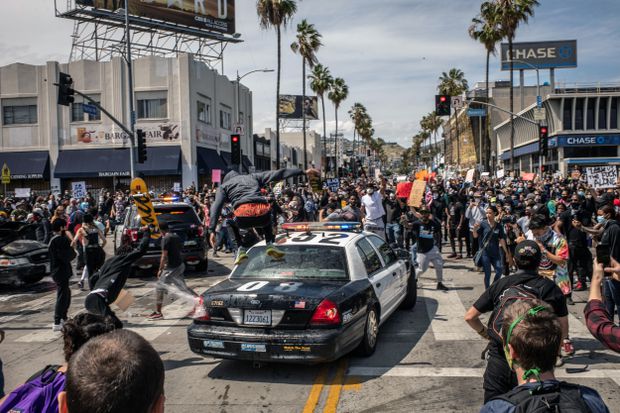US Cities Assess Protest Damage, Await Another Day Of Unrest
MINNEAPOLIS– America’s cities boarded up windows, swept up glass and covered graffiti Sunday as the country’s most significant night of protests in a half-century promised to spill into another day of unrest fueled by killings of black people at the hands of police.
The turbulence sparked by the death of George Floyd — a black man who died after being pinned under the knee of a white Minneapolis police officer — shook not only the streets of New York and Los Angeles, but dozens of smaller communities such as Fargo, North Dakota, and Lincoln, Nebraska. The damage extended even to buildings near the White House.
Peaceful protests involving tens of thousands of people on Saturday gave way, in some places, to rioting, looting and violence, with police vehicles torched, stores emptied and objects hurled at officers. The police response varied from restrained to aggressive, with officers at times firing tear gas and rubber bullets.
Police and peaceful protesters alike pleaded for a stop to violence, saying it only hindered calls for justice and reform.
“It only hurts the cause,” said Danielle Outlaw, head of the police force in Philadelphia, where more than 200 people were arrested as fires and looting engulfed Center City.
Disgust over generations of racism in a country founded by slaveholders combined with a string of recent high-profile killings to stoke the anger. Three months before Floyd’s death, Ahmaud Arbery was fatally shot as he jogged through a Georgia neighborhood. A white father and son are charged in the slaying. The month after Arbery was killed, an EMT named Breonna Taylor was shot eight times by Louisville, Kentucky, narcotics detectives who knocked down her front door. No drugs were found in her home.

Adding to that was angst from months of lockdowns brought on by the coronavirus pandemic, which has disproportionately hurt communities of color, not only in terms of infections but in job losses and economic stress.
The droves of people congregating in chanting demonstrations threatened to trigger new outbreaks, a fact overshadowed by the boiling tensions.
“We’re sick of it. The cops are out of control,” protester Olga Hall said in Washington, D.C. “They’re wild. There’s just been too many dead boys.”
The scale of the protests, sweeping from coast to coast and unfolding on a single night, rivaled the historic demonstrations of the civil rights and Vietnam War eras.
Curfews were imposed in places around the U.S., including Atlanta, Chicago, Denver, Los Angeles, San Francisco and Seattle. About 5,000 National Guard soldiers and airmen were activated in 15 states and Washington, D.C.
In Minneapolis, the city where the protests began, police, state troopers and National Guard members moved in soon after an 8 p.m. curfew took effect Saturday to break up demonstrations. The show of force came after three days in which police largely avoided engaging protesters, and after the state poured more than 4,000 National Guard troops into Minneapolis. Authorities said that number would soon rise to nearly 11,000.
President Donald Trump appeared to cheer on the tougher tactics, commending the National Guard deployment in Minneapolis and declaring “No games!” He said police in New York City “must be allowed to do their job!”
Presumptive Democratic presidential nominee Joe Biden condemned the violence as he continued to express common cause with those demonstrating after Floyd’s death.
“The act of protesting should never be allowed to overshadow the reason we protest,” Biden said in a late-night statement.

